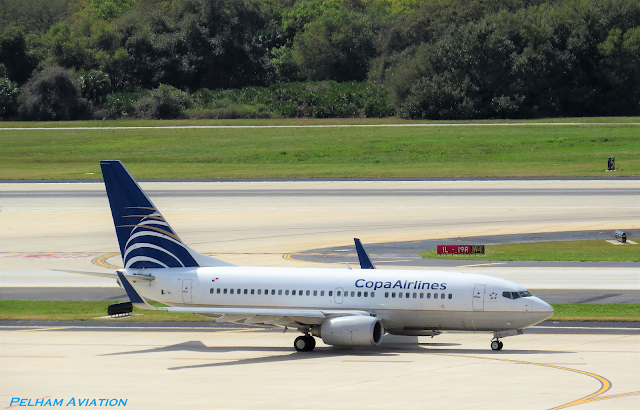Tampa to San Francisco Nonstop for 2 Years!
ROUTE
ANALYSIS: Tampa to San Francisco on United Hits Two Years of Service
May
18, 2019
By:
Michael Gutta
For this edition of the Pelham Aviation blog I’ve
decided to look back on the first two years of direct service from Tampa to San
Francisco on United Airlines. The airline announced on July 25, 2016 that it
would be starting a once daily service connecting the two cities on February
16, 2017. Prior to the direct-flight service kicking off, the airport reported
that roughly 600 passengers traveled this route daily, albeit with a
connection. According to the Tampa airport this was the largest unserved route
in America. With the daily service having begun in February 2017, it recently
surpassed two years of daily service by United Airlines. The passenger data
reported by the USDOT indicates, to no surprise, that this route has been
successful. In fact, United Airlines has announced that beginning on June 6,
2019 the route will be served twice daily, with an evening departure being
added to the existing morning departure. So, let’s get into the T-100 air
carrier data reported by the Bureau of Transportation Statistics.
The data for this investigation starts in February 2017 and extends through the end of 2018. The number of one-way departures during this time period reached nearly 700 on this daily scheduled flight. Almost 100,000 passengers flew from Tampa to San Francisco on this nonstop flight, showing an average load factor of 84.2%. This route also showed a decent amount of belly cargo (freight and mail) with over 567,000 pounds carried one way. The annual totals are shown below, with the seats and passengers rising year-over-year as 2017 was only served for 10 and a half months. Unfortunately, the average load factor dropped after the first year, but this could be due to larger aircraft being used, higher prices being charged by United, or lower prices being offered by competitors. Nonetheless, the load factor is something to monitor moving forward.
I also reviewed this route on a monthly basis to check
the seasonality of the route and see if any trends could be identified. Excluding
the inaugural month, the data showed that February of 2018 exhibited the lowest
passenger total, seat total, and load factor. Only 4,400 seats were offered in
the 28 days, and these were filled by only 3,140 passengers for a load factor
of 71.2%. On the positive side, June of 2018 showed a load factor of 95.7%.
Another notable discovery in the monthly investigation was that December of
2018 showed 43 departures, with a corresponding rise in seats and passengers.
Even with the rise in departures and seats for this month, the load factor was
still a respectable 78.6%. The summer months for this route performed well,
while January, February, and September lagged.
The final piece of this investigation was into
the aircraft type that United Airlines chose to fly for this route. The leading
aircraft by number of seats was the B737-900, which had 233 one-way departures.
The Boeing 737-800 was second in seats, but it was first by departures at 245. In
third place was the A320 with 202 departures. In a distant fourth place was the
A319 with only 16 departures. It will be interesting if this route will be
served by smaller mainline aircraft (-800 or A319) since it will be served twice
daily, though this is not reflected in the busy summer schedule. A check of
random dates in June show one departure each on the -800 and -900.
It’s honestly quite amazing that this route was
not served by a nonstop connection prior to February 2017. The nonstop flight
shows a block of between 5.5 and 6 hours. Among the 1 stop options available
are a Southwest flight through Phoenix (7 hours), a United flight through Denver
(7 ¼ hours), an American flight through Dallas-Fort Worth (7 ¼ hours), a Delta
flight through Atlanta (8 hours), and a Frontier flight through Denver (10 ½ hours
and the cheapest option). As stated previously, this route has so far served
96,500 passengers from Tampa to San Francisco alone. The two-way passenger
total is assumed here as double, for 193,000 passengers. The amount of time
saved by these passengers is incredible. Assuming they all opted for the
nonstop flight instead of the fastest 1 stop connection, a collective 289,000
hours was saved!
Moving forward, it would be interesting to see if
a competitor to United steps forward. The ULCC carriers have a very minor
presence at the 3 San Francisco area airports (SFO, SJC, OAK) so they aren’t
being considered here. However, Southwest Airlines serves all three airports and
already offers a flight to Florida from both San Jose and Oakland. With each
already having a connection to Orlando, would Southwest be interested in adding
a flight to nearby Tampa? Or, maybe farfetched, but would Southwest consider
flipping one of the two San Francisco area flights from Orlando to Tampa?
 |
| United Airlines Airbus aircraft landing on runway 19L at TPA on 12/8/2018 (Michael Gutta). |
Let me know your thoughts on this blog post and
potential future topics involving the Tampa International Airport, United
Airlines, or anything aviation related.
Data compiled for the report and figures above
came from the USDOT Bureau of Transportation Statistics T100 Tables. A few
other links to news stories are also shown below:
https://www.tampaairport.com/united-increases-service-to-sfo







Comments
Post a Comment